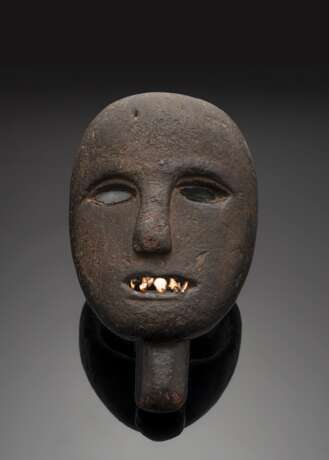ID 1094521
Lot 667 | Zeremonielle Hand-Maske aus Holz
Estimate value
€ 1 500 – 2 500
H. 25,5 cm
Auf der Insel Timor hat sich eine besondere Tradition von Tanzmasken entwickelt, deren genaue Herkunft und Bedeutung,oft ungewiss ist. Die vorhandenen Informationen deuten darauf hin, dass viele der Masken ihren Ursprung in Timor-Leste (Osttimor) haben. Sie stellten sowohl männliche als auch weibliche Vorfahren dar und wurden von Männern bei Tänzen und anderen Zeremonien getragen, darunter auch bei Siegesfeiern im Krieg. Die Masken wurden in der Regel bemalt und mit Fellstreifen oder Borsten verziert, die die Gesichtsbehaarung darstellten, und mit einem Kopfschmuck oder einer Kapuze getragen, die den Kopf bedeckte und die Identität des Tänzers weiter verschleierte. Holz mit stark krustiger Patina, Zahneinlagen im Bereich des leicht geöffneten Mundes und farbigen Glaseinlagen im Bereich der Augen. Das Volk der Atoni gehört zur grössten Volksgruppe der Inseln von Timor, die sowohl in West-Timor, als auch im westlichen Timor-Leste beheimatet ist. Die Atoni benuetzen im Bereich des Kultes zwei verschiedene Typen von Masken. Der Typus der Ahnenmasken ist Begräbnissen, Initiationen und Siegesfeiern gewidmet, der andere Maskentyp ist dagegen in Art einer Vorhaltemaske gestaltet, in Art eines “zweiten Gesichts”. Es wird angenommen, dass diese Art von Masken einen Diebstahl innerhalb der Dorfgemeinschaft bereinigen konnten. Der Dieb hielt sich bei Anschuldigungen die Maske vor das Gesicht, so dass die Maske zum Beschuldigten wurde, und der Angeklagte selbst “das Gesicht behalten” konnte und die Person so freigesprochen werden konnte.. Einige Masken wurden aus verderblichen Materialien hergestellt, aber Exemplare aus Holz, wie diese stark patinierte Arbeit, wurden konserviert und viele Male wiederverwendet.
Bedeutende bayerische Privatsammlung, erworben vor 2000
Publiziert: Galerie Alain Schoffel, 'Primitifs Art Tribal - Art Moderne', No. 4, Mai/ Juin 1991, S. 59
| Address of auction |
Nagel Auktionen GmbH Neckarstrasse 189 - 191 70190 Stuttgart Germany | ||||||||||||||
|---|---|---|---|---|---|---|---|---|---|---|---|---|---|---|---|
| Preview |
| ||||||||||||||
| Phone | +49 (0)711 649 690 | ||||||||||||||
| Fax | +49 (0)711 649 69696 | ||||||||||||||
| Buyer Premium | 29,5% | ||||||||||||||
| Conditions of purchase | Conditions of purchase | ||||||||||||||
| Business hours | Business hours
|



